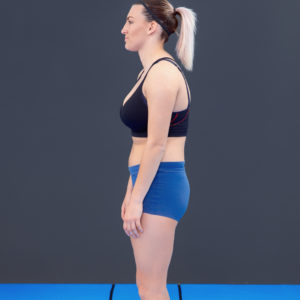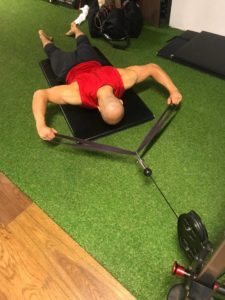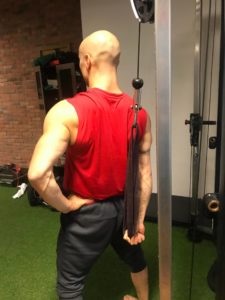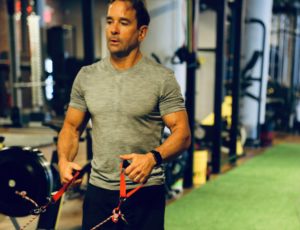6 Tips to Square Round Shoulders

Proven ways to correct this common postural fault
by Paul Gagné
Strength Coach and Posturologist
When you think of poor posture, the first image that often comes to mind is round shoulders. Rather than the confident, upright posture characterized by military soldiers, round shoulders present a sunken chest, drop shoulders, and a protruding chin. Throw in a pocket protector, and you have the stereotypical computer nerd.
To be clear, round shoulders presents an exaggerated curvature of the upper portion of the spine and excessive forward position of the shoulders and often the head. For those involved in sports that have an aesthetic component, such as gymnastics and figure skating, round shoulders are bad news.
During the Olympics last month, the ice dancing teams I worked with won gold, bronze, 8th, 9th, 10th, and 13th. Much of their early training focused on correcting issues such as round shoulders. Not only will postural issues affect their balance, but they will affect the overall presentation of their performance and be reflected in the judges’ scorecards. But it’s not just ice dancers who need to worry about their posture.
Round shoulders also impairs flexibility, which disrupts normal functioning of the muscles and increases the risk of shoulder instability and dislocation. Do you like to lift weights? Consider that a review in the June 2010 issue of the Journal of Strength and Conditioning Research found that the most commonly injured area during resistance training was the shoulder.
Another problem with round shoulders is that it can affect breathing. Yes, breathing.
The sunken chest associated with round shoulders compresses the diaphragm, affecting its function such as by creating a “metaboreflex response” that restricts blood flow to the limbs. The metaboreflex response explains the “heavy legs” feeling you get when you try to sprint and haven’t sprinted in a while. For detailed information about how to train the diaphragm to increase muscular endurance and aerobic capacity, refer to my Breathe Better webinar, available through StrengthSensei.com.
Besides the standard advice of being aware of your standing and seated posture, here are six guidelines to help you stand straight and tall.
- Strengthen Postural Muscles that Pull the Shoulders Back. The basic corrective exercise approach to addressing poor posture is to stretch the muscles that are tight and strengthen those that are weak. For round shoulders, three upper body muscles that need strengthening are the infraspinatus and teres major and minor as they are chronically stretched and fighting gravity. Also, the rhomboids and lower trapezius muscles should be strengthened.


Those with round shoulders should perform specific strengthening exercises to pull the shoulders back, such as the two shown here. This exercise, and many others that target postural muscles, will be discussed in detail in a future article.
- Take a Pause on Exercises that Pull the Shoulders Forward. In addition to working the muscles that pull the shoulders back, round-shouldered athletes should temporarily stop performing exercises that pull the shoulders forward, such as the bench press, chin-ups, and lat pulldowns. The problem with chin-ups and lat pulldowns is that one of the functions of the latissimus dorsi (lats) is to rotate the upper arm bones internally.
- Strengthen the Lower Abs. Weak lower abdominals (the area below the bellybutton) contribute to a forward tilt of the pelvis that can contribute to a round shouldered posture. Although the rectus abdominis is activated in virtually every abdominal exercise, it’s possible to emphasize specific segments of the muscle. One such exercise for the lower abdominals is the Garhammer Raise, an exercise developed by Dr. Richard Herrick and popularized by Dr. John Garhammer, Ph.D.
- Strengthen the Feet. You can’t adequately resolve problems such as round shoulders without first addressing the feet. Those who have rounded shoulders often have valgus [flat] feet, which create unnatural rotations in the legs that shift the body forward. The result is that the muscles of the upper body are always under excessive tension, fighting gravity. Such tension makes it even more difficult to stretch and strengthen the upper body muscles contributing to round shoulders.Proper footwear is important, but there are many exercises that can help reform the arch of the foot. One of the most important is the extensor hallucis longus, a muscle that lifts the big toe and creates lateral tension on the foot. One simple exercise you can perform is step-ups in bare feet. With the working leg perpendicular to the floor, lift the big toe up and step up. Perform 2-3 sets of 10 reps and increase resistance by holding dumbbells.
 Attention to posture involves not just exercise, but following good posture habits throughout the day, especially when sitting.
Attention to posture involves not just exercise, but following good posture habits throughout the day, especially when sitting.
- Strengthen the Calves. Often, those with valgus feet have atrophy in the two major calf muscles, the soleus and gastrocnemius. Devote some of your workout time to standing calf raises (for the gastrocnemius) and seated calf raises (for the soleus). Also, use a variety of foot positions to emphasize different portions of the calves. For example, pointing the feet outward strengths strengthens the lateral (outside) part of the calf and pointing them inward strengthens the medial (inside) part of the calves. Also, because the soleus contains a higher percentage of slow-twitch fibers, they should be trained with higher reps. For example, perform 12-15 reps for the standing calf raise and 25-30 reps for seated calf raises.
- Stretch Chronically Shortened Postural Muscles. Again, one aspect of corrective exercise is to stretch muscles that are tight. Among the muscles those with round shoulders often need to stretch the pec major and minor, latissimus dorsi, psoas, the gastrocnemius, and the soleus.
 Posturologist and strength coach Paul Gagné.
Posturologist and strength coach Paul Gagné.
As a bonus tip, I would say “Consult with a Posturologist.” A Posturologist can detail what are the main causes of your postural issues and develop an effective action plan to correct them. Besides exercises, they may prescribe postural insoles that stimulate the nerves on the bottom of the feet to reform the arch. There are also many simple eye exercises they can teach you that often produce dramatic, instantaneous changes in posture.
I will cover specific workouts designed to correct round shoulders in future articles, along with videos demonstrating the exercises. Until then, follow these seven tips to perform better, avoid injury, and look like an athlete! (PG)
